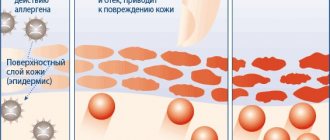Condoms are considered the best protection against sexually transmitted diseases and unplanned pregnancy. For many years they were made only from natural latex, and recently polyurethane protective equipment appeared on sale. You need to learn more about polyurethane condoms to decide whether they are worth buying and why.
- 2 Are there other hypoallergenic condoms?
- 3 Pros and cons of using hypoallergenic condoms
3.1 Contraindications to the use of polyurethane condoms
- 3.2 Features of using polyurethane condoms
- 4.1 Photo gallery: polyurethane condoms presented on the Russian market
Condoms - types
Condoms belong to the group of mechanical contraceptives.
Used mainly by men, but special condoms for women are also available on the market. Condoms not only prevent pregnancy , but also reduce the likelihood of contracting sexually transmitted diseases . Depending on the features and properties, there are various models of condoms on sale, differing in purpose and manufacturers.
Among the countless types of condoms, you can find models of different sizes, tastes, textures and thicknesses. Some condoms have additional functions designed to enhance pleasure for both partners, while others may be useful for men as a means of combating premature ejaculation. There are many types of condoms on the contraceptive market, differing in size or material from which they are made.
Popular brands of polyurethane condoms
In our world, there are already a sufficient number of brands that are used by modern youth and older people. Among them, the company Visit is the most popular. There are Sagami condoms, which, according to a survey, are also purchased quite often.
- Visit Nano-Tech,
- Sagami Original, Sagami Original Quick
- Durex Avanti.
Some useful information:
- Visit condoms are very elastic and large in size, unlike Sagami.
- The size of Japanese Sagami is not suitable for everyone - men often complain about the insufficient length.
- The condoms offered by the Japanese company provide the most realistic sensations during sexual intercourse. Very smooth to the touch.
Condoms - materials and properties
Also important are colors, shapes, tastes, aromas or lubricants, which accordingly stimulate the senses. Among the different types of condoms you can find are:
- Made from natural rubber or latex . This material is quite elastic and resistant to damage, but can cause allergies in some women and men.
- Latex-free - Due to the fact that they are made without the use of latex (polyisoprene, polyurethane or AT-10 synthetic resin), they are recommended primarily for allergy sufferers. Because they are very thin (but durable), they will also be appreciated by those people for whom latex condoms reduce their sense of pleasure.
- Condoms with spikes - thanks to their special surface, they enhance the sensations of both partners during sex.
- With different taste and aroma , can also stimulate partners' senses during sex. They are used mainly during oral sex.
- Available in a variety of colors , from nude to glow-in-the-dark.
- Treated with spermicide - increases the effectiveness of contraception.
- Wet condoms are equipped with additional lubricant that makes sex easier. Especially recommended for women suffering from vaginal dryness.
Cost and where to buy
Compare prices in the store
| Name | Price | Online store |
| 800 rub Buy | |
| Buy | ||
| 629 RUR Buy | ||
| 1550 rub. Buy | |
| 1340 rub. Buy | ||
| 3890 rub. Buy | |
| 2990 RUR Buy | ||
| 2800 rub. Buy | |
| 190 rub. Buy | |
| 179 RUR Buy | ||
| 499 RUR Buy |
Which condoms should you choose?
Which condoms are best? Which condoms should you choose and from what angle should you look at them to assess their suitability? No method of contraception guarantees 100% protection, but there are more or less effective contraceptive measures. It is best to choose condoms to suit your needs.
- The fact that a condom will be an effective method of contraception primarily depends on the skills of its use . For inexperienced lovers, this can be a problem.
- Therefore, if a condom is used primarily for protection, it is important to correctly size the condom so you can avoid breaking or slipping.
- Pay attention to the certificate and the integrity of the packaging . In this context, it is also advisable to use condoms treated with spermicide .
- For people suffering from premature ejaculation, lubricated condoms . These condoms are also ideal for anal sex. Flavored condoms are used for oral sex.
Spermogram norms:
INDICATOR NORMAL Volume Not less than 2 ml
Color White-grayish Liquefaction time 10-40 minutes pH 7.2-7.8
Number of sperm in 1 ml 20-120 million Number of sperm in ejaculate 40-500 million Actively motile (category A) No less than 25% Slowly motile (category B) A + B no less than 50% Non-progressively motile (category C) C + D no more than 50% Immobile (category D) Pathological spermatozoa No more than 50% Number of round cells No more than 5 million Spermagglutination No Leukocytes Up to 3-5 per field of view
When studying spermogram data, the doctor pays attention to the following spermogram indicators:
- Normal sperm volume is 3-5 ml (about 1 teaspoon). A decrease in the amount of sperm released usually indicates decreased function of the testicles and gonads. Such spermogram results indicate possible male infertility.
- number of sperm in 1 ml of semen. The spermogram norm is 60-120 million/ml in 1 ml. A bad spermogram will show a lack of sperm in the semen (oligozoospermia) or their complete absence (azoospermia).
- sperm motility. Normally, a spermogram will show 60-70% active, 10-15% weakly motile and 20-25% immobile sperm. The normal ratio would be 70-80% of live sperm and 20% dead, up to 20% of pathological sperm is also considered normal. The predominance of immobile sperm in the sperm (necrospermia) is an alarming signal indicating male infertility or the presence of inflammatory diseases of the male genital area.
- a normal spermogram shows the absence of any impurities or mucus in the sperm. Blood in sperm (hemospermia), microflora, red blood cells, leukocytes (more than 10), epithelial cells (more than 2-3) are a deviation from the norm, and therefore symptoms of urological diseases.
- the spermatogram also takes into account other indicators (acceptable norm in brackets): sperm viscosity (0-5 mm), pH (7.2-7.4), liquefaction time (20-30 min), fatigue (percentage of mobile forms after 1 hour decreases by 10%, after 5 hours - by 40%), the speed of sperm movement (3 mm/min) and many others.
What condoms should I buy?
Many studies have been conducted that confirm the fact that not all men can choose the right size and model of condom.
Many men use condoms that are not the right size for them and do not take into account their intended purpose.
An incorrectly selected condom means not only a lack of comfort during sexual intercourse, but also the possibility of the condom slipping off. These are problems with achieving orgasm. Therefore, choosing the right condom will not only improve your sex life , but also reduce the risk of problems.
There is a huge variety of condoms in every size on the market today. Therefore, in order to choose your own correctly, you must follow simple rules, in which the main ones are the width and length of the penis.
How to take a spermogram correctly?
In order to submit sperm for analysis and obtain reliable spermogram results, you must comply with some requirements:
- abstain from sex and masturbation for at least 3-4 days
- do not drink alcohol (even beer), medications
- You can’t take a steam bath or sauna; it’s better to wash in the shower.
- It is better to take a spermogram in the laboratory of a specialized clinic through masturbation or interrupted sexual intercourse. Moreover, it is better to correctly submit sperm for analysis without using a condom, since when it comes into contact with latex and the substances with which the condom is impregnated, the sperm lose their mobility, and accordingly the results of the spermogram will be unreliable.
If you decide to take a spermogram at home, avoid exposing the sperm to direct sunlight and overcooling the sperm. Use a sterile container to collect sperm. Try to save all semen released for analysis. The loss of some sperm, especially the first portion, makes the overall picture of the spermatogram inaccurate. To make a correct diagnosis, you will have to submit sperm for analysis 2-3 times.
Condoms - sizes
Choosing the correct width of condoms is a very important step because if chosen poorly, unintentional slippage or excessive tightness can occur, causing discomfort.
If a condom is too small, it may burst during intercourse. It is important to remember that manufacturers indicate the width of the condom on the packaging ; as a rule, the dimensions of the condoms when rolled up are also indicated there. Therefore, this number can be safely multiplied by 2. There is no need to add that a condom of the right size is the best way to protect yourself and your partner during sexual intercourse.
Before choosing, you need to know the standards that are used in condoms.
- For example, in America the unit of measurement is inches (2.54 mm). Standard US sizes are 49, 51 (2 inches) or 54 mm).
- In Europe, particularly in countries such as England, Germany, and the Netherlands, the nominal width range is from 49 to 56 mm. Therefore, in Europe, condoms are usually manufactured in the following 3 sizes: 49, 52 and 56 mm. If the width is converted to diameter, we get 31 mm, 33 mm and 35 mm, respectively.
- Which condom best suits your needs? Before determining the size, answer yourself the question: are you allergic to latex ? If so, you need a non-latex material such as polyurethane or polyisoprene. You should also know if your partner is allergic to latex.
- The next question is - do you use a condom only for protection, or should it be a source of additional sensations? There are many condoms designed specifically for women and their pleasure or for mutual pleasure, and even condoms made primarily for male arousal (textured on the inside).
Decoding the spermogram
Ejaculate liquefaction time is the first sperm parameter studied. The ejaculated semen is usually a coagulum, meaning it is not completely liquid. After some time, the ejaculate becomes liquid under the influence of prostate enzymes contained in the seminal fluid. Liquefaction is determined by the change in sperm viscosity. To do this, the ejaculate collected in a syringe is released through a special needle. Viscosity is measured by the length of the “thread” trailing behind the released drop. Sperm is considered liquefied if the “thread” does not exceed 2 cm. Normal sperm liquefies in 10-40 minutes (in some laboratories, liquefaction within one hour is considered normal). If liquefaction is delayed or does not occur at all, this may indicate disturbances in the functioning of the prostate gland.
Ejaculate volume is one of the most important characteristics of sperm. Together with sperm concentration, this indicator gives an idea of the total number of sperm ejaculated during sexual intercourse. A volume of less than 2 ml may be considered a cause of male infertility (oligospermia). The point is not only that a small ejaculate contains few sperm. Even if the concentration of sperm is high, and their total number far exceeds the required 40 million, there is still a threat to normal conception.
When erupted into the vagina, sperm find themselves in aggressive conditions. The acidic environment of the vagina is detrimental to sperm and most of them die within 2-3 hours. During this time, the most mobile and “healthy” sperm should have time to penetrate the uterus, where the conditions for their life are favorable (sperm can remain mobile in the uterus and fallopian tubes for three days or more). Seminal fluid (or seminal plasma) temporarily alkalizes the vaginal environment, making it less acidic, and allows active sperm to enter the uterus. It is believed that a small volume of seminal fluid “cannot cope” with this task: the less seminal fluid, the less time it can restrain the acidity of the vagina.
In addition, seminal plasma locally suppresses the spouse’s immunity (after all, for a woman’s immune system, sperm are like foreign microorganisms). And from this point of view, volume also plays a significant role.
However, too much sperm volume does not give a man any advantages. As a rule, no more than 5 ml of ejaculate is placed in the vagina, while the extra milliliters flow out and do not participate in conception.
Due to the importance of determining semen volume, the patient should collect as much of the ejaculate as possible into a container. In case of loss of more than one-fourth of the ejaculate intended for analysis, it is necessary to inform the clinic specialist about this. It should be borne in mind that the first part of the ejaculate is the richest in sperm.
Unfortunately, in some cases there is no ejaculation at all, despite the sensation of orgasm. This may indicate so-called “retrograde ejaculation” (ejaculation into the bladder). In such cases, it makes sense to examine the urine after orgasm to see if there are sperm in it.
Ejaculate color . Most men have sperm that is “white-greyish” in color. Numerous shades: milky white, yellowish, transparent cannot clearly indicate any violations. The only exception is the ejaculate that is “pinkish” in color, indicating hemospermia - an increased content of red blood cells in the sperm.
value , or, more simply put, the acidity of the ejaculate, can often be an important clue in determining reproductive and sexual dysfunction. Normal ejaculate has a slightly alkaline reaction (pH 7.2-8.0). A change in this indicator in one direction or another from the norm, if there are no other deviations, cannot indicate any violations. But in combination with other signs it influences the diagnosis. For example, an increased pH with an increased content of round cells and non-liquefaction of sperm will strengthen the specialist’s opinion about a possible disorder of the prostate gland of an infectious nature; a lower pH with azoospermia will give hope for its obstructive nature (there are sperm, but the ejaculatory ducts are blocked), etc. Still, the basic properties of sperm can be determined by examining it under a microscope.
Sperm count is the first thing that experts pay attention to. Usually the amount is expressed as a concentration (so many millions per milliliter). In a normal ejaculate there are at least 20 million sperm per milliliter (at least 40 million in total sperm volume).
The motility of sperm is no less important than their number, because what good is a lot of sperm if they don’t move. It is customary to divide sperm into 4 categories of motility.
Category A includes sperm with fast and linear movement; their speed of movement must be at least 0.025 mm/s (that is, at least half of its own length per second). Category B includes sperm with slow linear movement, a speed of less than 0.025 mm/s, but the trajectory of movement is still straight. Category C includes sperm that do not move in a straight line (both those that barely flounder in place and those that run in circles). Finally, category D - completely immotile sperm. All categories of mobility are always present in the ejaculate. Typically, the majority of immobile sperm are category D (from 40% to 60%), as a rule, these are dead or dying “from old age” sperm. Therefore, the less abstinence before ejaculation, the fewer immobile sperm in the ejaculate. There are also usually a lot of fast, straight category A sperm (40-60%), these are healthy, “young” sperm that have recently formed in the testicles. Non-progressively motile sperm of category B are usually 10-15%; these are, as a rule, sperm with abnormalities in the structure of the neck and flagellum, or “aging”. Also, there are usually few spermatozoa that are slow with straight movement, category C (5-15%).
In normal fertile sperm, there should be at least half of progressively motile sperm (A+B), or at least a quarter of fast progressively motile (A). Sperm motility is influenced by many factors. An important factor is temperature: at body temperature (about 37C) the speed of movement is maximum, at room temperature it decreases, and at temperatures below 10C the sperm hardly moves. It is not uncommon for sperm that are classified as category B at room temperature to be classified as category A when viewed at 37C. Therefore, in a number of laboratories, the sperm microscope is equipped with a special heated “thermal table” adjusted to 37C.
There are methods that allow you to find out how many sperm among the immotile ones are alive. To do this, the sperm is tinted with eosin. This red substance cannot penetrate the membrane of the sperm, but the membrane of the dead sperm is quickly destroyed, and it turns red. This method makes sense to use in case of akinozoospermia - complete immobility of spermatozoa, in order to find out whether this immobility is associated with death or disorders of the flagellar apparatus. Accordingly, a fertility treatment plan can be developed.
The proportion of abnormal sperm is determined by two methods. The first is the study of the morphology of sperm in the native ejaculate, that is, the sperm as it is (native) is examined under a microscope. At the same time, they try to count how many sperm out of 100 are abnormal. This method is very inaccurate, because, firstly, not all pathologies can be seen without special treatment of the sperm, and secondly, the sperm move and are difficult to examine in detail. When abnormal sperm exceeds the barrier of 50%, the morphology of sperm is studied on a stained smear. To do this, a drop of sperm is smeared on a glass slide, dried in a stream of air, treated with alcohol, dried again, immersed in several different dyes, washed off excess paint and placed in a special balm for microscopy. After this treatment, the sperm are immobilized, colored and glued to the glass. They can be easily examined and counted, and abnormalities that are invisible with the first method (for example, the absence of an acrosome) can be detected.
To assess sperm quality, not only the proportion of abnormal sperm is considered (it should be less than 85% in a stained smear), but also the average number of pathologies per sperm (the so-called sperm disorder index, SDI) and the average number of pathologies per abnormal sperm (the so-called teratozoospermia index, TZI). If the TZI value exceeds 1.6, the sperm is considered abnormal, and if the SDI value exceeds 1.6, problems may arise even with artificial insemination.
Spermagglutination, or sperm gluing , is a signal of serious immune disorders, which, unfortunately, is not always given due attention. It is often incorrectly thought that agglutination prevents sperm from moving freely and reaching the egg. This is not true. Adhesion itself usually affects a small part of the sperm and does not interfere with the movement of the majority, but the presence of agglutination may indicate the presence of antisperm antibodies in the ejaculate, which can cause infertility. True spermagglutination is not always easy to recognize; sometimes special methods are required to distinguish it from sperm aggregation.
Sperm aggregation is a sticking together caused not by immune causes, but by the mucus contained in the seminal fluid. Spermagregation does not affect sperm fertility.
Antisperm antibodies (ASA, or ASAT) are the body's antibodies against sperm. By connecting to the flagellum, ASA inhibits sperm movement. By sticking to the head, they prevent fertilization. ASA can form in both men and women, causing infertility. To diagnose ASA in sperm, various methods are used, the most common of which is the MAR test (Mixed Immunoglobulin Reaction).
In addition to sperm, the ejaculate contains so-called round cells. This collective name refers to leukocytes and immature cells of spermatogenesis, that is, the cells from which mature sperm are formed in the testicles. Normally, the concentration of leukocytes should not exceed 1 million/ml. It is generally accepted that a high concentration of these immune cells may indicate inflammatory processes in the accessory sex glands (prostate or seminal vesicles). Without special staining, it is difficult to distinguish leukocytes from immature spermatogenic cells, so WHO recommends staining if the total concentration of all round cells exceeds 5 million/ml.
What are the best condoms?
So, what are the best condoms? Everything depends on our needs. There is no optimal condom that is perfect for every man. That's why it's so important to know their types.
- , ultra-thin condoms are the preferred option For most couples, thin condoms mean more pleasure and a feeling of intimacy. However, these condoms undergo the same rigorous testing, so thinner does not mean less protection. These condoms are not recommended for people who struggle with premature ejaculation. In this case, a thin condom provides more sensation and stimulation, which will obviously only speed up the moment of ejaculation.
- Such people should rather choose thicker . These are durable and high quality products that will protect against disease and accidental pregnancy. These are cheap contraceptives. Despite all the advantages, latex condoms are not recommended for people with sensitive skin and latex allergies. Polyisoprene is recommended for them. This material has all the positive characteristics of latex, but does not cause allergies.
Types of condoms and their sizes
Most men are sure that condoms are universal. Meanwhile, this is not true. It is not the type of condom that affects our feelings, but its size. This is the key parameter when it comes to choosing the right product.
A 2010 study by The Kinsey Institute for Research on Sex found that using the wrong condom more than doubles the risk of erectile dysfunction and reduces contraceptive effectiveness. In general, the ease of use of a condom primarily depends on its width, so keep in mind the standard condom sizes:
- S (small) - the length of the product is intended for a penis up to 17 centimeters. The width is approximately 44-52 millimeters.
- M (medium) - suitable for an element with a length of 17-19 cm and a width of 52-56 millimeters.
- L (large) - suitable for people with a phallus length of 19-22 centimeters and a width of 56-65 millimeters.
- XXL (very large) - created for men with a penis length of 19-23 centimeters and 65-69 millimeters in width.
- Consequences of poor condom selection
All letter designations on condoms are conditional. Each product company has its own maximum size. When purchasing, pay attention to the parameters indicated on the packaging.
Latex condoms have an error of approximately +3 millimeters . The decisive factor when choosing a condom is not only its length or density, but also its width. This diameter affects the quality of sensation and safety. The wrong condom can make sexual intercourse much more difficult. Possible problems may include:
- Redness of the penis (a tight condom compresses the blood vessels of the penis).
- Loss of sensation in men.
- Lack of erection
- Condom breakage
- Shortening the duration of sexual intercourse (early ejaculation may be a consequence of discomfort).
- Pain at the base of the penis due to a condom that is too tight
The ideal condom can be selected experimentally. So don't be afraid to experiment and change condoms.
- If the tip of the penis is wider than the base, you may want to choose a product with a slightly larger volume.
- To select the correct size, the diameter of the penis must be halved. The width of the product is indicated on the packaging of contraceptives.
- The length of the condom has virtually no effect on the characteristics of sexual contact, especially for the average size of the penis - from 13 to 18 centimeters. If the length of the penis exceeds 20 centimeters, then a man can use a product designed for 17-19 centimeters. If the penis size is less than 13 centimeters, a condom of any length will do.
What condoms looked like among the ancient Egyptians and Casanova
The condom (from Latin praeservare, to protect), or condom, has been known since ancient times. In different countries this product has its own special nickname. In Italy it is called the “glove”, in France - the “English hood”, in England - the “Parisian”.
The history of the improvement of the condom is a good illustration of technological progress. It is impossible to confirm the authenticity of the legend that the wife of King Minos of Crete created the first condoms from the bladder of a goat leather pouches by the Egyptians for contraception (ca. 2000 BC).
But researchers’ descriptions of the use of condoms by the ancient Greeks and Romans no longer raise doubts. The conquerors, going on campaigns, stocked up with sets of products made from dried sheep intestines. In China they were made from oiled silk paper, in Europe - from cotton, flax, and fish bladders. Naturally, then condoms were reusable. They were washed, then soaked in a special solution, dried and put in a box, and then taken out as needed.
With the spread of Christianity, when regulating pregnancy became a grave sin, the idea of using condoms was consigned to oblivion. But since the middle of the 16th century, an epidemic of syphilis, which is associated with the return of members of Columbus's expedition, covers Europe and spreads throughout the world. During this period, the Italian physician and anatomist Gabriel Fallopius, author of the treatise “The French Disease, or Syphilis,” proposed in 1564 to protect against syphilis by putting a linen bag soaked in a chemical solution on the penis. Whether this proposal stopped the spread of the disease is unknown, but it definitely revived the idea of the condom.
Condom, the court physician of the English King Charles II (1630–1685), is recognized as the inventor of the condom. On behalf of the king, who wanted to limit the number of heirs to the throne, he invented and launched the production of condoms from the caecum of lambs. The oldest condom found dates back to around this time period.
From the memoirs of Casanova (1725–1798) we learn that this famous practitioner of sexual relations constantly used condoms. In his memoirs we read: “I showed my friends a new invention of the British - safety bags, the purpose of which is to save the fair sex from all sorts of complications. I explained how to use them, and they were absolutely delighted!”
Condom width - how to check it?
About 20% of men use condoms that are too small. At the same time, about 30%, on the contrary, use condoms that are too large. So, how to choose the width of condoms - how to check it so as not to experience discomfort?
To choose a condom size, you need to consider the following parameters:
- Penis length. You can measure it using a tape or a regular ruler - from the head to the base of the penis.
- Average width of the penis. To do this, the girth size at the base of the penis, the diameter of the middle of the phallus and the volume at the top should be divided by three.
- Diameter of the head of the penis. Using a measuring tape, measure the volume of its widest part.
To correctly measure your size, a man must stand upright with his penis erect. When partially excited or lying down (sitting), it is impossible to take accurate measurements. It happens that a condom chosen by size, made of excellent material and produced by a well-known company still does not fit. It can be cramped, uncomfortable and cause allergies. Such problems arise in the following cases:
- The measurements were taken in a room that was too cool.
- Inaccurate measurements of the glans penis
- There was no full erection during the measurement.
- A rare form of phallus and other anatomical features of the genital organ.
How to wear: features
In order for an ultra-thin condom to fulfill its protective functions, it is necessary not only to store it carefully, but to carefully open it and put it on correctly.
To do this you need:
- Use a new condom every time.
- Open carefully without using teeth, scissors or sharp objects.
- The condom is put on before making contact with the partner's body.
- A rolled condom is placed on the head of the erect penis. In this case, the seminal receptacle is compressed with two fingers. Thus, air is released from it and space is freed up for sperm.
- The condom gently rolls along the shaft of the penis.
- After ejaculation, the used product is removed along with the penis. The protection must be held at the base, preventing it from slipping.
In any case, we must remember that the condom is intended for one-time use only. Once opened and unused, it is better to simply throw it away.











